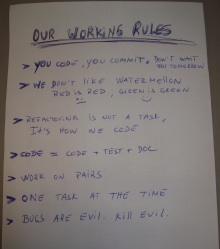How it started
- 5 to 9 people
- Cross-functional (Programmers+ testers+ UX+..)
- Members should be full-time
- Self-organized
- Collaborative
- Autonomous, regarding how to achieve commitments
- Self-managed
- Stable – same team throughout the product sprints
- Negotiates commitment with Product Owner
Cargo Cult Phenomenon
Where Teams come from
Teams are usually born from some managers decision, who puts people togethe r according to their skills and project needs. Thin balance. Then everyone will expect you to work as team. But you need time to grow yourself as a team, and you need a purpose…kindness and a lot of good will. You need to want it first. To see value from doing it.
r according to their skills and project needs. Thin balance. Then everyone will expect you to work as team. But you need time to grow yourself as a team, and you need a purpose…kindness and a lot of good will. You need to want it first. To see value from doing it.
I see people as runners. I may say they are all running for the same team, but in the end, everyone will try to score the first place, last thing that will cross their minds is to look back and reach out for the last mates.
As a Scrum Master, as a proud employee I actually don’t want that to happen. I don’t want people to wait for the slow runners. I want my team to win and I want them all to be fast.

So, there is no magic potion to make this happen. No silver bullet. You can dress them up all alike, link their prizes and defeats..whatever. It won’t work. You’ll still have fast and slow runners.
People will get even less motivated, conflicts will rise, along with the will to abandon the team (and trust me, you won’t get rid of the slower runners.. you’ll lose both the slow and the fast runners). And this will happen to you as well.
I believe there’s one thing you can do. I don’t know if it will work with you. I’m not here to sell silver bullets (hate them. my favorite has always been the werewolf).
From 1 to Many
Take them all to the start point. Point out where’s the finish line. Then tie their legs to each other.
They’ll figure out how to get to the end all together. Yes, you’ll have casualties during the first meters. They’ll discuss, argue, complain, some will even try to quit or start a fight – that’s when you should be around and remember why they’re there and point out the finish line. Focus on finish line.
They will figure out out to deal with faster runners and slower runners. They’ll figure out whom should be in the middle whom will be better outliners. And in the end you’ll be amazed by how simple and adequate it was the way they figured out to do stuff.
You won’t have 1 but many runners. They’ll all improve their timings and grow stronger, together.



A very insightful article, I really enjoyed it Cátia. Thanks for sharing it with us :-)
Good one Cátia. Well put. Sharing it now ;)
Hi! Glad you liked it! :) thanks master João